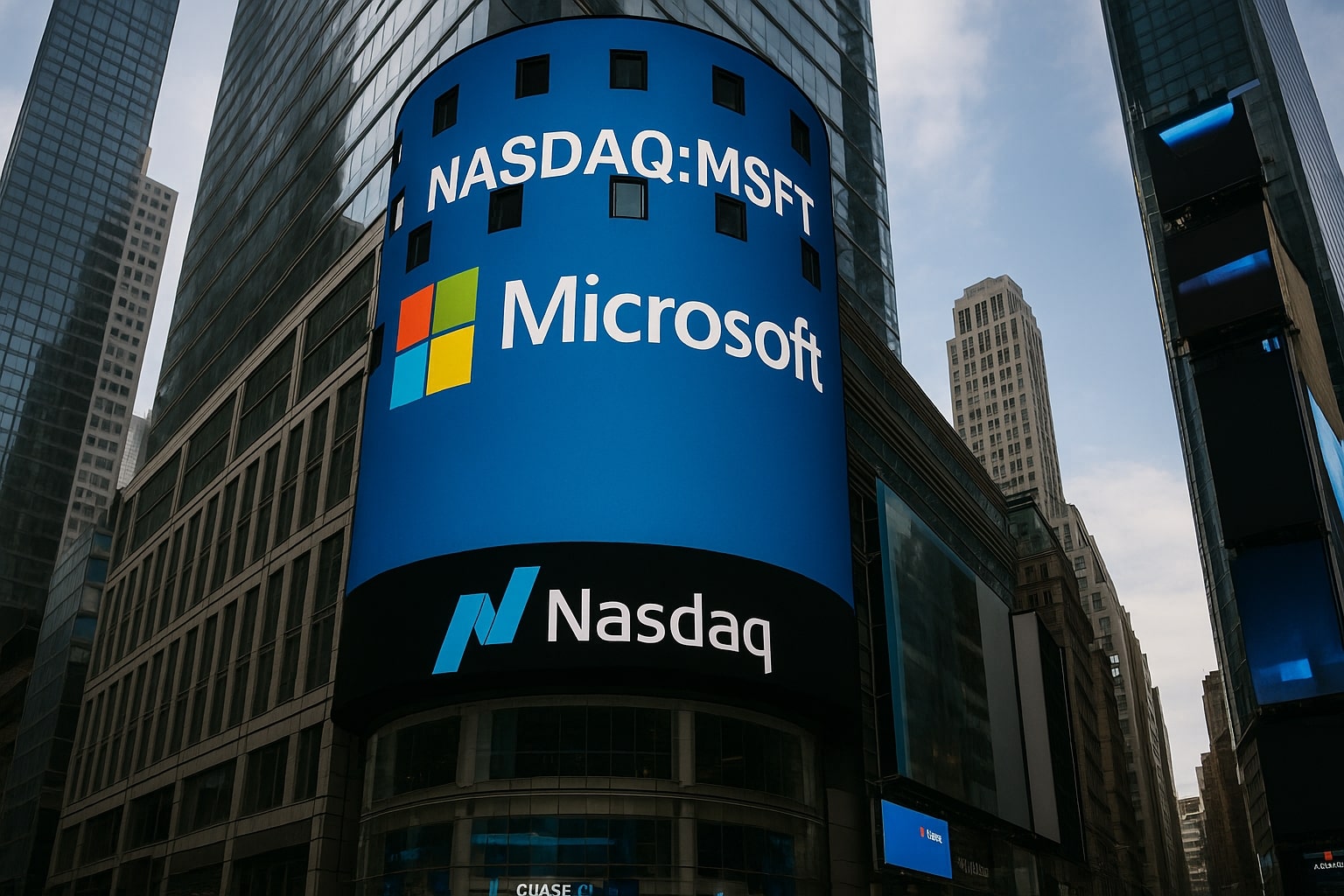
Microsoft Stock Forecast: (NASDAQ:MSFT) Shares Hold $510 as Azure and AI Fuel Growth
Rising CAPEX, dividend strength, and AI-driven adoption put Microsoft’s $3.77T valuation to the test as analysts eye upside beyond $600 | That's TradingNEWS
NASDAQ:MSFT Stock Forecast: Microsoft Trades Near $510 With Azure, AI and CAPEX in Focus
Microsoft Corporation (NASDAQ:MSFT) is holding near $509.64 after hours, only a few points below its 52-week high of $555, with the stock up 28% over the last six months and carrying a market capitalization of $3.77 trillion. The company’s latest quarter delivered $76.4 billion in revenue, up 18% year over year, with operating income climbing 23% to $34.3 billion and net income reaching $27.2 billion, or $3.65 per share, a 24% increase. That earnings beat has reinforced confidence in Microsoft’s ability to sustain premium valuations even as capital expenditures rise aggressively. Investors are now asking if the stock, which trades on a forward P/E of 32.6, is priced for perfection or still offers room to run as Azure and AI dominate the growth narrative.
Azure and AI Dominate Growth for NASDAQ:MSFT
Azure remains the crown jewel, generating more than $75 billion annually and growing 39% year over year. With Azure directly integrated into Microsoft’s ecosystem of Office 365, Teams, Windows, and LinkedIn, switching costs are high, and customer lock-in is deep. Every Copilot seat sold adds Azure compute demand since AI inference workloads run on Azure GPUs, creating a flywheel effect. Microsoft’s exclusivity with OpenAI ensures that ChatGPT and related models run entirely on Azure, giving the company an edge over Amazon Web Services and Google Cloud. Today, more than 65% of the Fortune 500 use Azure OpenAI Services, a level of enterprise penetration that competitors cannot easily replicate. This AI-driven adoption rate is unprecedented and cements Microsoft’s strategic position.
Valuation Premium and Market Expectations for Microsoft
With a price-to-sales ratio of 13.4 compared to a sector median of 3.2, and enterprise value-to-sales of 13.2 against a sector median of 3.1, Microsoft trades at a 260%+ premium to peers. Investors justify paying these multiples by betting on sustained double-digit growth, recurring subscription revenues, and strong free cash flow generation. Microsoft delivered $136.2 billion in operating cash flow over the last twelve months and $61.1 billion in free cash flow, allowing it to absorb CAPEX spikes. Still, the rising CAPEX demands are significant: $17.1 billion last quarter compared to just under $10 billion two years ago. The CFO/CAPEX coverage ratio has fallen from about 4x pre-2023 to 2.5x in the most recent quarter, showing that 40% of cash from operations is now devoted to investment. The company argues this build-out is necessary to expand AI infrastructure, and investors so far are willing to grant it the runway.
Dividend Growth, Insider Activity, and Shareholder Returns
Alongside heavy reinvestment, Microsoft continues to reward shareholders with dividend growth. The latest quarterly dividend was $0.83 per share, up 11% year on year from $0.75. This pace of dividend growth aligns with management’s projected long-term reinvestment and return on capital employed of 67.3%, which when combined with a reinvestment rate of 17.5%, suggests sustainable profit growth of 11–12% annually. Insider activity, as tracked on Microsoft’s profile, shows limited insider selling, with institutional holders controlling over 74% of shares outstanding. That level of institutional backing highlights confidence in management’s strategy, even with mounting CAPEX intensity.
Financial Strength and Competitive Moat
Microsoft posted $281.7 billion in revenue over the trailing twelve months, with a 36.1% net margin and a 44.9% operating margin, outpacing most peers in large-cap tech. Return on equity of 33.3% and return on assets of 14.2% demonstrate efficiency, while $94.6 billion in cash and short-term investments provide balance sheet strength to cover $112.2 billion in debt. The company’s market position is entrenched: governments, enterprises, and educational systems depend on its stack. Even Elon Musk’s xAI “Macrohard” announcement, aiming to build AI-native productivity software, has barely dented Microsoft’s moat. The network effects of Windows, Office, Azure, and exclusive AI partnerships mean disruption risk is low in the medium term.
Trading Dynamics and Outlook for NASDAQ:MSFT
At current levels around $510, Microsoft trades below the average analyst price target of $614.60, with bullish estimates stretching as high as $675. Earnings growth is expected to remain above 15% annually, with Q1 2026 EPS projected at $3.66, up from $3.30 a year ago, and full-year EPS at $15.52. Revenue is forecast to reach $322.6 billion in FY2026 and $370 billion in FY2027, sustaining double-digit growth. Short interest remains minimal at 0.76% of float, underscoring broad institutional support. The technical picture shows consolidation after the pullback from $555, with the 50-day moving average around $507 providing immediate support. A move through $520 would likely re-ignite momentum toward new highs.
NASDAQ:MSFT Stock Forecast: Buy, Sell, or Hold?
Microsoft is in a rare position where fundamentals, balance sheet strength, and AI-driven growth converge. The stock’s premium valuation is justified if Azure maintains near-40% growth and Copilot adoption accelerates across enterprise software. Risks center on CAPEX outpacing cash flow and potential margin compression if cloud growth slows. At $510, with a forward P/E of 32.6 and strong visibility into earnings, the risk-reward still leans positive. The verdict: NASDAQ:MSFT remains a Buy, supported by durable AI infrastructure demand, a dividend growth profile above 10%, and upside to $600+ over the next year.
That's TradingNEWS
Read More
-
JEPQ ETF Holds $58.82 as Fund Flows Cool and Nasdaq Valuations Stretch
06.12.2025 · TradingNEWS ArchiveStocks
-
XRP ETFs Cross $1 Billion AUM as XRPI and XRPR Lead Institutional Wave
06.12.2025 · TradingNEWS ArchiveCrypto
-
Natural Gas Price Breakout: NG=F Soars to $5.50 on Cold U.S. Weather & LNG Export Boom
06.12.2025 · TradingNEWS ArchiveCommodities
-
USD/JPY Price Forecast - Dollar to yen Slides to 155.60, BOJ Hike Reprice Global Currency Markets
06.12.2025 · TradingNEWS ArchiveForex


















